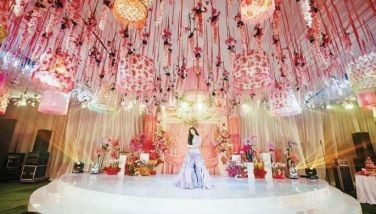A Catalan adventure
MANILA, Philippines – Catalonia is also known as Catalan or Catalunya bordering the Pyrenees region of France and Spain. Catalan, like our ARMM, is an autonomous region of Spain. It has its own language (Catalan) and doesn’t want to be categorized as Spaniards hence their own flag. One of the very few aspects where Catalans and Spaniards agree is on cuisine. You will find in the Catalan region and elsewhere in the whole Spain boquerias, bistros, restaurants and eating places where the food is the same. From tapas to seafood to paellas to Manchego to Iberico ham.
Andorra
I started my Catalan adventure at the seldom visited by Pinoys principality of Andorra. It is the alternative entry point to Barcelona nestled between the French and Spanish alps. It is a monarchy jointly governed by two princes — the Spanish Roman Catholic bishop of Urgell and the president of France. Andorra is one of the smallest countries in Europe (181 square meters) with a population below 90,000. Despite its size, Andorra is visited by over 10 million tourists annually and has the highest life expectancy in the world. Andorra is the Hong Kong or Singapore of Europe where shopping is fabulous and all goods from low-end cameras and electronics to high-end watches like Rolex, Cartier, etc. and designer goods from Hermes to Louis Vuitton are duty free. Andorra is one of the favorite ski resorts of Europeans and is also a tax haven.
The drive to Andorra from Lourdes took me four hours through mountainous passes, scary zigzags and narrow roads beside towering cliffs. Predominant language is Catalan but Spanish, French and English are widely spoken. The principality has embraced Catalan cuisine, culture and customs. The main streets are dotted with hundreds and hundreds of stores, selling various wares from clothes to leather to jewellery. Name the brand and chances are you’ll find it. I found it cute that they even had a Giordano shop which is a Hong Kong brand. We spent one chilly Andorrable night at the art deco-inspired hotel Plaza where the breakfast is superb and the ambiance reeks history.
Mercat de St. Josep Las Ramblas
Early next morning, we embarked on a two-hour-plus drive to Barcelona on a four-lane crowded freeway. I chose Hotel Espana as my headquarters in Barcelona because it was the hotel closest to the legendary Mercat de St. Josep de Boqueria where I planned to steep myself in Catalan and Spanish cuisine and delicacies.
Guided by my not so trusty GPS, it took me over an hour going in circles trying to locate Hotel Espana. No wonder I couldn’t find it — the street was closed to private vehicles. Check in was quick and although the hotel is over a century old, our room was spacious with all the modern creature comforts.
After unpacking, me and my ex-girlfriend Madelin took a five-minute walk from the hotel to Mercat de San Josep, where my senses were assaulted by a medley of gastronomical smells, vivid colors and a cacophony of sounds that was music to my ears. This must be Heaven with a capital “H.” There were so many shops and tapas bars. Dozens and dozens of stalls displayed legs and cuts of various jamon Iberico brands like Joselito, Cinco Jotas, Enrique Tomas, Montaraz, etc. in different vintages and age.
The most expensive at €185 a kilo and the cheapest at €75. I went crazy tasting the jamon until I couldn’t tell the difference. I couldn’t afford this luxury in Manila or even Hong Kong where a small appetizer plate already costs over a thousand pesos. Besides the jamon, there were shops that sold nothing but Bacalau (cod) fresh, sliced, dried and what have you. Fresh fruit and veggie shops that exploded in various colors of the rainbow with delectable jams and preserves; queso shops that peddled Spanish cheeses like Manchego in various ages and textures.
With all the food I saw, my stomach started rumbling and hurriedly settled at one of the tapas bars. We ordered luscious oysters, langoustine (ulang in Filipino), freshly harvested morels sautéed in butter and bacalao with cheese and tomato infusion. It was a gastronomic feast I won’t forget. Burp! On the way back to the hotel, I munched on a packet of Jamon Pata Negra with French Fries and picked up a few packets of Enrique Tomas Jamon Iberico to take home. Unfortunately, the few vendors of Jamon Iberico in the Philippines don’t carry this brand yet. Best bet to find the largest selection of Jamon Iberico in Manila is Terry’s at Pasong Tamo extension where gourmet chef JC Terry holds fort.
Barcelona
No visit to Barcelona would be complete without visiting the landmark Sagrada Familia Basilica. Catalan architect Antoni Gaudi got involved in the construction of the Gothic/Art Nouveau landmark in 1883 and at the time of his sudden death in 1926, was only 15-percent finished. It is projected that it would be completed in 2028 and has been included in UNESCO’s World Heritage Sites.
After spending over an hour appreciating the Sagrada Familia Basilica from the perimeter which we weren’t able to enter because tickets have been sold out, we decided to walk an eight-kilometer route back to our hotel. Along the way, we saw lots of cafés and tapa bars, slot machine parlours (yes there is an abundance of this in Barcelona), a couple of Corte Ingles (the counterpart of SM Malls or Ayala Malls which you will find all over Spain), fountains, parks and Hard Rock Café Barcelona where I found the friendliest waiters and attendants among the over 50 Hard Rock Café’s I’ve visited worldwide. Unfortunately, the prices of T-shirts and garments were not as friendly as those at Hard Rock Café Makati.
Along the Las Ramblas area, hundreds of shops selling souvenirs, toys, food and even plants lined the main thoroughfare ending at the 197-feet tall Monument a Colom or the Christopher Columbus monument erected in 1888 as a reminder that Columbus reported to Queen Isabela I and King Ferdinand V in Barcelona his first trip to the new continent. Close to the monument is the popular Diagonal Mar shopping center accessible by boardwalk with dozens of shops and cafés
On the day I checked out, I accidentally discovered that the Hotel Espana where I spent three days was the same hotel where Jose Rizal first established residence in 1882 when he arrived in Barcelona. I could imagine our National Hero walked the same marble steps I am now stepping on over 133 years ago. Goosebumps galore! That put the exclamation mark on my Catalan adventure
- Latest
- Trending































